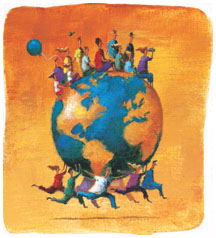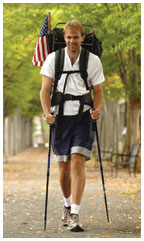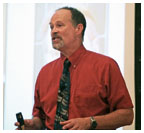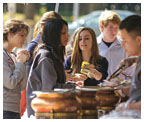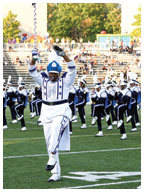
|
November 7, 2007: Notebook
Princeton and the world
Globalization prompts new international initiatives
Endowment increases to $15.8
billion
Princeton responds to Senate debate on tax issues
For Jeopardy! star,hiking for a cause
Graduate School casts a wide net
Recalling the Cuban missile crisis
Princetonís Nobel Prize Connections
A new chapter opens as Princeton hosts Hampton
(Illustration by Paul Zwolak) |
Princeton
and the world
Globalization prompts new international initiatives
With a goal of preparing students to become “worldly cosmopolitans,” Princeton is launching a series of initiatives that will bring a stronger international dimension to research and teaching.
“In order to be a great American university, Princeton must integrate the national and international domains into a cohesive education enterprise,” President Tilghman and Provost Christopher L. Eisgruber ’83 said in “Princeton in the World,” a 12-page report announcing the new proposals.
Among the highlights are:
• The “expectation” — though not a mandate — that every Princeton undergraduate experience another country, whether this is a semester abroad, a seminar in a foreign city, or a summer internship or job overseas.
• Recruitment of outstanding scholars from around the globe who would visit and teach on a recurring basis. Eventually the University hopes to have 15 or more Global Scholars on campus each year.
• Encouraging faculty to travel abroad and to steer their research and teaching in international directions.
• Support for research travel by graduate students and visits for collaborative work by graduate students from other countries.
The report advised against investing in satellite campuses in other countries, as other universities have done.
Tilghman said in an interview that based on initial cost estimates, $50 million to $75 million would be needed to endow the program to ensure stable funding. These funds will be part of the $1.75 billion fundraising campaign that kicks off Nov. 9.
More than $1 million has been allocated from the record-breaking 2006–07 Annual Giving campaign to begin several of the initiatives, including the Global Scholars, graduate student travel, expansion of the Study Abroad Program, and creation of a Global Initiatives Fund to provide seed grants for new ventures.
Serving as a foundation for the report was the work of two separate groups: a faculty advisory committee headed by history department chairman Jeremy Adelman and Woodrow Wilson School dean Anne-Marie Slaughter ’80, and a report on study-abroad opportunities by the dean of the college’s office.
Undergraduates faced “very significant” obstacles in the past to spending semesters abroad, such as required independent work, “but we are trying to eliminate the institutional barriers,” Tilghman said. Though many students still may not be able to travel abroad during the academic year, she said there are “tremendous opportunities for growth” in summer programs.
A survey of the Class of 2006 found that 38 percent had participated in at least one international activity, and of these, 59 percent took part in more than one such activity.
Tilghman said she expects to move quickly to create a new Council on International Teaching and Research, recommended by the Adelman-Slaughter committee, that will develop detailed strategies.
A new faculty committee probably will be named to explore an issue tabled by the Adelman-Slaughter group, Tilghman said — a review of the University’s foreign-language training. Adelman said the advisory committee also decided not to pursue the issue of whether Princeton’s efforts should have a particular geographic or thematic focus.
Professor Katherine Newman, director of the Princeton Institute for
International and Regional Studies, said the report offers “a powerful
set of priorities to move out beyond our confines.” Princeton is
“more than ready to run with a new vision,” she said. ![]()
By W.R.O.

Annual Return of Private universities with endowments of $8 billion or more Yale: 28.0% For fiscal year 2007. Sources: Princo, Stanford News Service, The New York Times, and The Boston Globe. |
Endowment
increases to $15.8 billion
Princeton responds to Senate debate on tax issues
With a 24.7 percent return on investments, the University’s endowment reached $15.8 billion at the end of the 2006–07 fiscal year, the Princeton University Investment Co. (Princo) reported in October.
Princo’s returns have topped 16 percent in each of the last four years, and during the last decade, the endowment has compounded at an annual rate of 16.2 percent. Though volatility dampened some markets in the months since the June 30 close of Princeton’s fiscal year, the endowment managed a 2 percent return in the first quarter of the current year. “The world got a little bit more challenging, and we’re happy to report that we continue to make money,” Princo president Andrew Golden said.
Among the five private universities that started the year with endowments of $8 billion or more, Princeton’s return ranked second, behind Yale (28 percent) and ahead of Harvard (23 percent), Stanford (23 percent), and M.I.T. (22.1 percent). While Golden was pleased with last year’s return, he noted that his office devotes more time to “planting” than “harvesting.” Overseas investments will continue to be a priority for Princo, he said.
As the large endowments reported impressive growth, testimony at a Senate Finance Committee hearing questioned how universities were using their largely tax-exempt funds. Princeton defended its endowment spending practices in a letter to the committee, which scrutinized nonprofits in a Sept. 26 discussion of offshore tax issues. Sen. Max Baucus, D-Mont., the committee chairman, tied colleges to the conversation by noting that “nonprofit investors sometimes invest in hedge funds through offshore entities incorporated in low- or no-tax jurisdictions” to avoid unrealized business income tax.
Two witnesses — Jane Gravelle of the Congressional Research Service and Lynne Munson of the Center for College Affordability and Productivity — suggested changing tax policy to force universities to control increases in tuition. “Since tax breaks for charitable donations are supposed to contribute to the public good,” Sen. Charles Grassley, R-Iowa, later told The Chronicle of Philanthropy, “it’s fair to ask whether the tax breaks that lead to big university endowments are serving the public.”
Princeton’s response, written by Vice President and Secretary Robert Durkee ’69, contended that the University’s endowment acts in the public interest by supporting a substantial financial-aid program. More than half of undergraduates and “essentially all” graduate students receive aid, he wrote, noting that Princeton “treats its financial aid budget as an entitlement, not an appropriation,” placing no limit on the number of aid applicants who can be admitted. In 2007–08, the University’s scholarship budget is $81 million, and its net tuition revenue is $75 million.
The endowment also supports research, teaching, and other expenses.
A rule set by the trustees ensures that the University spends between
4 and 5.75 percent of its endowment accounts each year (4.6 percent in
2007-08). Endowment spending and annual gifts fund 52 percent of Princeton’s
$1.2 billion operating budget, according to Durkee. ![]()
By B.T.

(Photo by Frank Wojciechowski) |
For Jeopardy! star, hiking for a cause
Hiker David Madden ’03 passed through Princeton in mid-October,
about 1,000 miles into what he hopes will be a five-month trek from New
Brunswick, Canada, to the Florida Keys. To honor former roommate Alex
Wilson ’03, an Army first lieutenant who was wounded in Iraq earlier
this year, Madden is using his travels to raise money for Fisher House,
a charity that builds and manages temporary residences near military hospitals
for the families of wounded veterans. Madden, a former “Jeopardy!”
champion, is writing about his experiences at usahiker.blogspot.com. ![]()

Graduate School casts a wide net
In their new report on Princeton’s global initiatives, President Tilghman and Provost Christopher Eisgruber ’83 describe the Graduate School’s student body as “remarkably internationally diverse,” and the numbers bear them out.
Of the 2,290 degree candidates enrolled at the Graduate School in 2006–07, 881 — or 39 percent — were from other countries. Of the degree candidates who entered this fall, 40 percent were international students — a significant increase from the early 1990s, when the percentage was in the low to mid 30s, according to Graduate School dean William Russel.
For the past five years, China, by a wide margin, has sent more graduate students to Princeton than any other country outside the United States, with Canada and India in either second or third place. A dozen countries have sent at least 20 new graduate students each year.
The economics and engineering programs have the highest percentages of international students: 73 percent of the students seeking a Ph.D. in economics and 61 percent of the two-year master’s program in finance come from abroad, while 54 percent of all engineering Ph.D. candidates are international students.
Of the 137 international students who received their doctorates in 2007, more than three-fourths planned to stay in the United States, Russel said, reflecting a national trend. About half of those alumni were planning to work as postdocs and the other half had permanent positions, he said.
International students face challenges beyond those confronted by their American-born peers, yet many say Princeton’s Graduate School has made the experience relatively smooth.
Ning Lin, a third-year Ph.D. student in civil and environmental engineering, is a native of China who says that activities organized by the Graduate School have been “very helpful for a newcomer to learn about American and local culture.” Lin said her husband recently joined her after she had been in the United States for four years, and she is grateful that the University allows spouses to “use the libraries, audit courses, and participate in activities.”
Mark Davidson decided to apply to Princeton after he found himself working on a field study with Princeton professor Tullis Onstott *81 for his undergraduate thesis in South Africa. Onstott became his adviser at the Graduate School, and Davidson is now in the final stages of his Ph.D. work. “Coming from a developing country to somewhere as efficient, affluent, and nurturing as Princeton was quite a culture shock,” Davidson said. But he said he has made friends from around the world, linked by the knowledge that “we all have to jump through the same hoops of fire as those before us did.”
Davidson expects to start work as an environmental consultant in California in January through the Optional Practical Training (OPT) visa program.
For many Ph.D. recipients planning an academic career, the United States
has a special appeal. “Where would you go? You’re at the mecca,”
said Lynn Loo *01, a native of Malaysia who recently returned to Princeton
as an associate professor of chemical engineering, “The intellectual
freedom and creativity that are allowed — it’s a culture no
one else has been able to reproduce anywhere else.” ![]()
By W.R.O.

(Photo by Hyunseok Shim ’08) |
“People of faith would say that science doesn’t carry us as deeply into the mystery of life as we would wish to go. And that is not a rejection of science, but rather the recognition that science has limitations. Not every question that is worth posing or worth answering can ultimately be answered scientifically.”
Kenneth R. Miller, professor of biology at Brown University, speaking
Oct. 10 in McCosh 50 on “Evolution and Design: At the Crossroads
of Science and Religion.” ![]()

(Woongcheol Yang ’10) |
More than 1,000 students and community members got a taste of South Asian
culture Oct. 13 at a mela, or fair, sponsored by the South Asian Students
Association. Vendors sold food, clothes, and jewelry, and henna artists
and hookah stands were available. South Asian student organizations including
dance groups Naacho and Kalaa and drama group PSAT performed throughout
the day at the fair, which was held at Scudder Plaza. ![]()

President John F. Kennedy "knew what war was and did not want war," Theodore Sorensen told a Princeton audience. (Sameer A. Khan/Fotobuddy Photography) |
Recalling the Cuban missile crisis
In October 1962, on the morning after Nikita Khrushchev agreed to remove Soviet missiles from Cuba and end the most nerve-racking standoff of the Cold War era, speechwriter and special counsel Theodore Sorensen spoke with President John F. Kennedy and another presidential adviser outside a conference room at the White House. The news, the second adviser said, had made Kennedy seem “10 feet tall” in the world of international diplomacy. The president replied, “That’ll last a couple of weeks.”
To Sorensen, it has lasted 45 years. On Oct. 10, he joined two other panelists at the Woodrow Wilson School to discuss the Cuban missile crisis. Sheldon Stern, the former historian of the JFK Library, spoke about the tapes of the National Security Council’s executive committee meetings, which revealed a litany of potentially disastrous suggestions that Kennedy rejected. Julian Zelizer, a professor of history and public affairs at Princeton, analyzed the heated atmosphere in domestic politics that preceded the crisis. But Sorensen was the main attraction.
At age 79, Sorensen spoke with no notes and briefly covered the timeline
of the crisis’s 13 days. After a U-2 spy plane photographed the
missile sites in Cuba, Kennedy convened a small circle of advisers, to
ensure secrecy, and when it came time to communicate with Khrushchev,
he called on Sorensen to draft the letter. Conversations about that first
letter eventually steered Kennedy toward the idea of a naval blockade,
or in the president’s words, a “quarantine against offensive
weapons.” Sorensen later worked with Robert Kennedy to write the
American reply that would help resolve the conflict. President Kennedy’s
approach throughout the crisis was to ask for every option, military or
diplomatic, unilateral or multilateral, according to Sorensen. His experience
as a naval officer in World War II also shaped his decisions. “He
knew war, and did not want war,” Sorensen said. ![]()
By B.T.

(steven veach) |
Good listeners
Galapagos marine iguanas cannot communicate vocally to alert each other
to danger, but they have developed an alternative method for dodging predators:
eavesdropping on local mockingbirds, whose songs change tune when hunting
hawks approach. Ecology and evolutionary biology graduate students Maren
Vitousek, James Adelman, and Nathan Gregory and a colleague from the University
of Bath in the United Kingdom tested the iguanas’ ability to discriminate
between mockingbird songs and alarm calls using digital recordings. For
a nonvocal species, the iguanas displayed “a remarkable degree of
auditory discrimination,” the authors reported, vigilantly perking
up when the alarm call sounded. The study, published in Biology Letters,
showed for the first time that a nonvocal species can detect approaching
threats by listening to another species’ alarm calls. ![]()

Princeton’s Nobel Prize Connections
Princeton faculty members played a part in the project that won the Nobel Peace Prize Oct. 12, while a visiting Princeton professor, Eric Maskin, shared the prize in economics.
The peace prize was shared by Al Gore and the Intergovernmental Panel on Climate Change (IPCC), which was honored for its efforts to “build up and disseminate greater knowledge about man-made climate change, and to lay the foundations for the measures that are needed to counteract such change.” Ten Princeton professors were among the thousands of scientists and officials who have contributed to that project in recent years: Leo Donner, Anand Gnanadesikan, Isaac Held, Gabriel Lau, Denise Mauzerall, Michael Oppenheimer, Venkatachalam Ramaswamy, Jorge Sarmiento, Robert Socolow, and Robert Williams. Their work is in the fields of geosciences, atmospheric and oceanic sciences, and public and international affairs.
Oppenheimer was a lead author of a report presented to the United Nations in April. “The Nobel Committee’s recognition of the IPCC is very encouraging to the thousands of scientists over the years who have dedicated large amounts of time for these reports,” he said. “The recognition makes it clear that expert advice means something.”
Maskin, who since 2000 has been a visiting lecturer with the rank of
professor in economics, was one of three scholars to share the economics
prize this year. The Albert O. Hirschman Professor of Social Science at
the Institute for Advanced Study, Maskin is a leading figure in economic
theory and “mechanism design” theory, which explores the design
of institutions in situations where markets do not work properly. He lives
in the Princeton home that was once the residence of Albert Einstein.
![]()

Hampton University’s marching band during the halftime show Oct. 6. (Beverly Schaefer) |
A new chapter opens as Princeton hosts Hampton
Princeton’s Oct. 6 football game against Hampton University marked the first time the Tigers have played a historically black college or university in football. Though Princeton lost, 48–27, students and faculty said the schools’ meeting was an important one.
“The game marked the beginning of a wonderful new chapter in Princeton’s relationship with historically black colleges,” said Daphne Brooks, associate professor of English and African American studies. “Given the rich cultural history of these institutions, it’s exciting to see Princeton developing interactive ties with Hampton and other institutions that might continue to open the doors to continuing cross-cultural exchanges” between the Ivies and other historically black colleges, Brooks said.
Hundreds of Hampton fans showed up to cheer, boosting total attendance to 15,329, a high number for a non-Ivy game. Students said that the energy level was higher than at many games at Princeton Stadium, noting “The Force,” Hampton’s marching band of about 200 students, and the large number of fans. “Seeing what black colleges put into football, especially the halftime show, was a good cultural experience for a lot of people,” said Daniel Dickerson ’10, a Virginia native who had seen Hampton play in high school.
“It was different and really exciting,” said Princeton wide receiver Austin Gill ’10. “Hampton is ranked nationally, and we knew they were going to be a really good team,” he said.
Fans felt positively about the new matchup. “It should definitely be a continued trend,” Dickerson said. “It’s helpful to have some samples of what other lifestyles are like outside of the Princeton bubble.” The Tigers will face Hampton again in 2011.
Brooks delivered a fall football lecture the morning of the game, and
the Association of Black Princeton Alumni held several events, including
a tailgate gathering and an open house at Stanhope Hall, the new home
of the Center for African American Studies. ![]()
By Claire Abramowitz ’10

BOAZ BARAK, assistant professor of computer science at Princeton, and EMIL YUZBASHYAN *04, an assistant professor of physics and astronomy at Rutgers University, have received Packard fellowships that recognize “unusually creative researchers” in their first three years of teaching. Each of the 20 recipients receives an unrestricted research grant of $625,000 over five years. Barak is a theoretical cryptographer; Yuzbashyan’s field is condensed-matter physics, focusing on superfluidity.
Charges of serving alcohol to a minor have been filed against the presidents of TIGER INN, COTTAGE CLUB, and CLOISTER INN; in each case, a person under the age of 21 required medical attention. Borough prosecutor Kim Otis said in mid-October that he was considering charging the graduate boards of the clubs with maintaining a nuisance. Conviction, he said, would give the judge the right to close the club for up to a year.
Five clubs — Terrace, Tiger, Cloister, Quad, and Colonial — have faced charges related to underage drinking since May 2006. Otis said in an interview that he believes the clubs have made some progress — but not enough — in their efforts to keep minors from drinking. Prosecutions of club officers have not proven to be a deterrent, he said, and his goal is to involve the graduate boards because they have “the institutional memory and a stake in the future.”
Otis conceded that closing a club would be “harsh,” adding that he is not on a crusade against the clubs.
But he said he would press to make sure that drinking is “not
excessive and does not put people’s lives at risk.” The
Daily Princetonian, noting in an Oct. 17 editorial that the three
clubs were considering going off tap indefinitely while the threat of
closing loomed, warned that it would be potentially more dangerous for
drinking to shift to unsupervised room parties. ![]()

